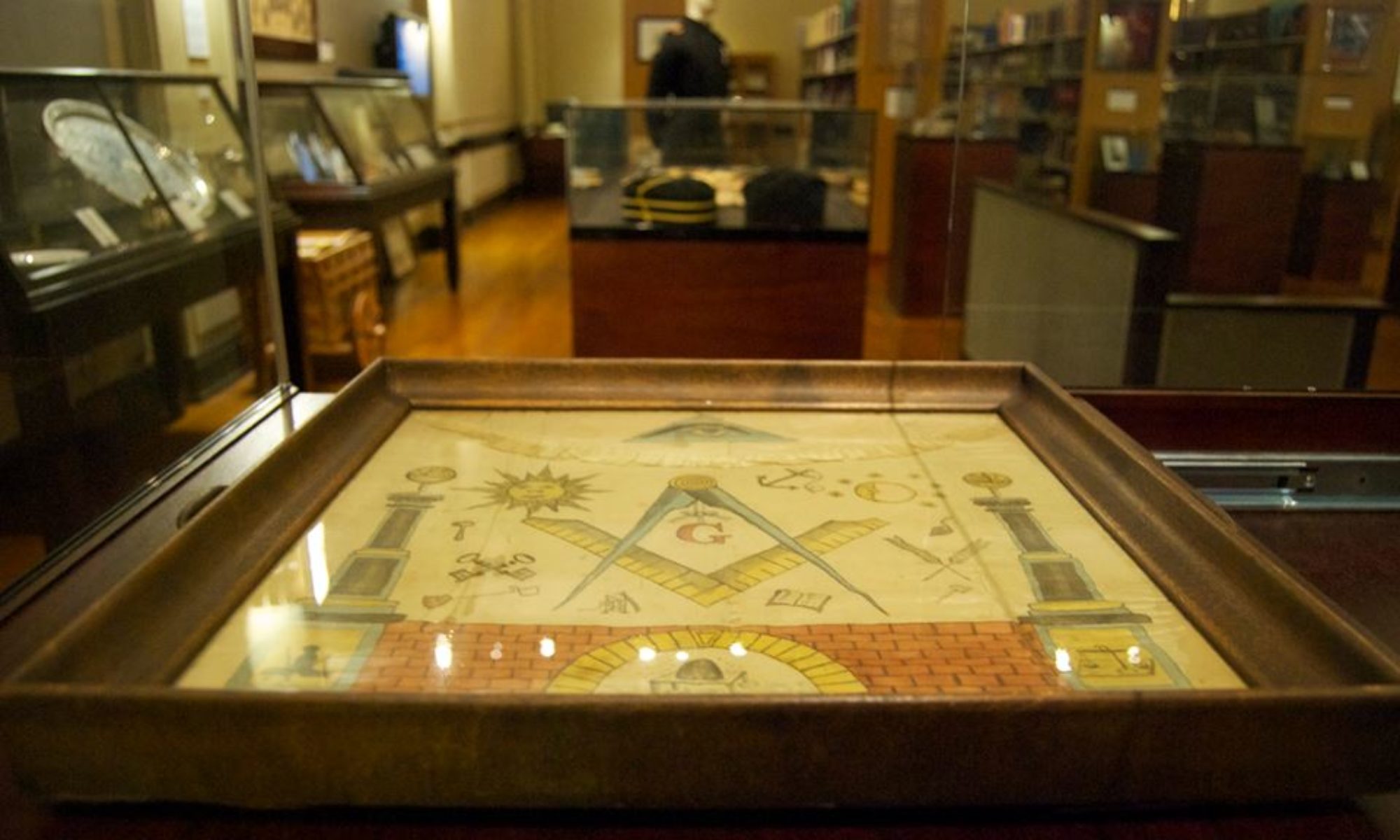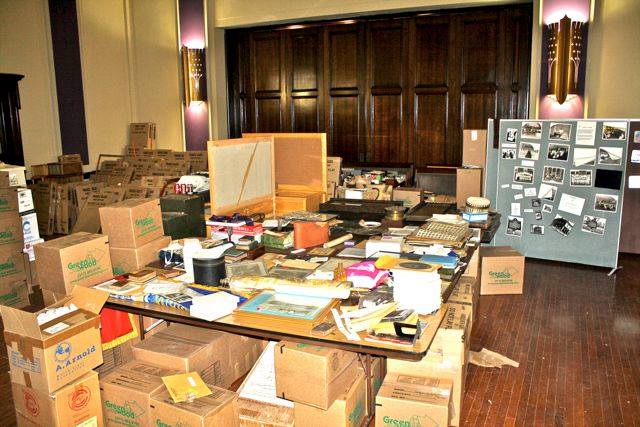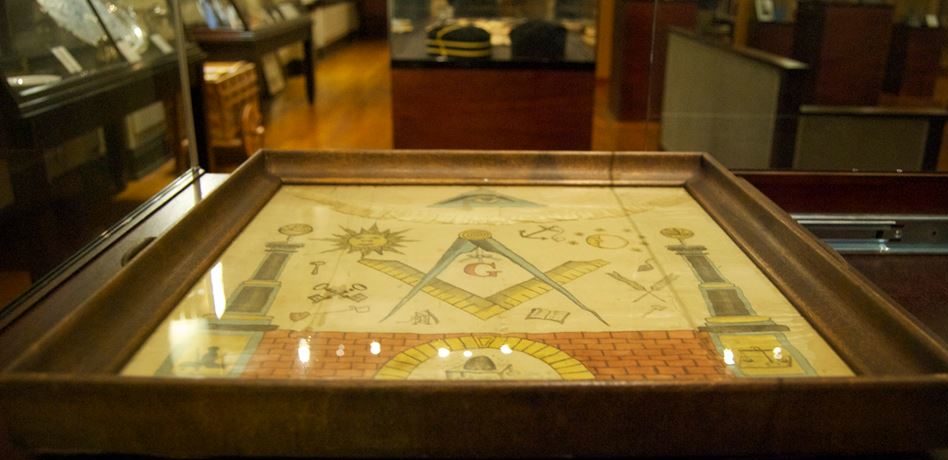 The Masonic Library and Museum of Indiana, Inc., is a special not-for-profit 501(c)(3) corporation operated by the Grand Lodge Free and Accepted Masons of the State of Indiana. Founded in 1987, and incorporated in 1989, the MLMI is the Grand Lodge’s official repository of Masonic artifacts and printed materials pertaining to the Masonic history of the Hoosier State. It also contains items of interest from other Masonic jurisdictions around the world, and other fraternal organizations, both Masonic and non-Masonic.
The Masonic Library and Museum of Indiana, Inc., is a special not-for-profit 501(c)(3) corporation operated by the Grand Lodge Free and Accepted Masons of the State of Indiana. Founded in 1987, and incorporated in 1989, the MLMI is the Grand Lodge’s official repository of Masonic artifacts and printed materials pertaining to the Masonic history of the Hoosier State. It also contains items of interest from other Masonic jurisdictions around the world, and other fraternal organizations, both Masonic and non-Masonic.
Please see our donations page to find out how to help support the work of the MLMI. For more about the history of the MLMI, please scroll down.
The Corporation is operated by a Board of Directors, who are appointed for varying term lengths by the Grand Master of Masons in Indiana. The Board elects its own officers, and reports each May on its activities and acquisitions to the Grand Lodge sitting in its Annual Communication.
The current officers are:
Christopher L. Hodapp, PM, President and Director
Michael D. Brumback, PGM, Vice President
James R. Dillman, PM, Treasurer
Current Members of the Board are:
Richard J. Elman, PGM, Grand Secretary
Jeffery P. Zaring, PGM
William A. Reiners, PGM
Nathan C. Brindle, PM
John Bridegroom, PM
The Masonic Library & Museum of Indiana
(Excerpted from Heritage Endures (2017) by Christopher L. Hodapp, PM)
The Beginning
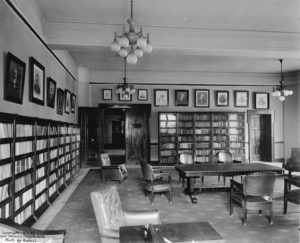 The northwest half of the ground floor at the Grand Lodge headquarters in the Indianapolis Masonic Temple originally contained a fair-sized reading library and public sitting area when it was built, but the book collection continued to grow in size over the decades. By the mid-1960s, Grand Secretary Dwight L. Smith obtained more and more research material for his Sesquicentennial book, Goodly Heritage, and the celebration’s various programs. More shelving units were bought, more floor space was gobbled up, but it continued to swell. Additionally, more objects and artifacts began to be handed to the Grand Lodge by lodges themselves, or donated by individual collectors or their families.
The northwest half of the ground floor at the Grand Lodge headquarters in the Indianapolis Masonic Temple originally contained a fair-sized reading library and public sitting area when it was built, but the book collection continued to grow in size over the decades. By the mid-1960s, Grand Secretary Dwight L. Smith obtained more and more research material for his Sesquicentennial book, Goodly Heritage, and the celebration’s various programs. More shelving units were bought, more floor space was gobbled up, but it continued to swell. Additionally, more objects and artifacts began to be handed to the Grand Lodge by lodges themselves, or donated by individual collectors or their families.
After more than twenty years of haphazardly collecting, displaying, and eventually up piling rare Masonic artifacts in closets, the Grand Lodge of Indiana finally decided something safer and more permanent had to be done. In 1987, the Grand Lodge formally named a Board of Directors for the Masonic Library and Museum of Indiana (MLMI).
The Franklin Years
The year 1989 was one of enormous activity for the new Library and Museum under the leadership of PGM Robert “Gus” Stevens, who was an archivist for historical collections at Vincennes University. Early in the year, the brethren of Jackson Lodge No. 146 generously donated $8,000 to help get the ball rolling on displays and preservation. Because its role was designed to educate the public and to preserve the Masonic history and heritage of Indiana, the MLMI was officially formed into a 501(c)(3) corporation to facilitate tax-deductible donations. But the biggest issue was one of space. The Indianapolis Temple didn’t have any more to spare at the time. While the capital city was more centrally located and ideally most conducive to attracting visitors and walk-in traffic, a big opportunity presented itself farther south, in Franklin.
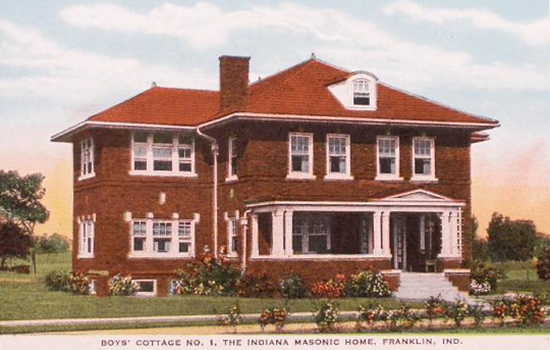 The former Boy’s Cottage on the campus of the Masonic Home had recently been made use of as the offices for the Scholarship Board and the Indiana DeMolay—and was referred to as the DeMolay Building. Nevertheless, much of it was empty, and even more space was soon predicted to be available. Consequently, Grand Master John E. Grein (1989-90) gave the MLMI Board permission to move the nascent Library Museum there. The move was accomplished by 1990, and Grein authorized a fundraising mailer that brought in another $105,000 in a single year. At last, they could get to work.
The former Boy’s Cottage on the campus of the Masonic Home had recently been made use of as the offices for the Scholarship Board and the Indiana DeMolay—and was referred to as the DeMolay Building. Nevertheless, much of it was empty, and even more space was soon predicted to be available. Consequently, Grand Master John E. Grein (1989-90) gave the MLMI Board permission to move the nascent Library Museum there. The move was accomplished by 1990, and Grein authorized a fundraising mailer that brought in another $105,000 in a single year. At last, they could get to work.
The move worked out well at the time, as it permitted full-time supervision. The Library Museum shared a receptionist with the Scholarship Board, so someone was always there to unlock the door and answer telephone calls. Further, a shop that had been established by the Grand Lodge years before to fulfill orders for books, forms, regalia, gifts, and other Masonic-related items had outgrown its tiny space in the Administration Building. So, in 1993 the Indiana Masonic Supply Shop also moved into the DeMolay Building, and its manager Roger VanGorden performed double duty as the curator for the Museum. By that point, the MLMI had taken over the entire second floor.
On the library side, Joseph E. Burton, PGM was hired by MLMI President Gus Stevens to take on the job of sorting the thousands of books, and he began taking library science courses. Burton eventually organized the swelling collection, labeled, and manually cataloged them into a card file. The MLMI was enrolled in the Online Computer Library Center (OCLC) system, which opened up the world of networked computerized library referencing. This predated the easy era of Kindle, GoogleBooks, .pdf files, and other digitized books and records available online. It was considered the state of the art in library organizing at that time.
Stevens and Burton’s involvement also tapped the MLMI into information that the Grand Lodge and countless researchers knew little or nothing about before. They discovered that the famous Robert Archer Woods Masonic Collection was moved from Indiana University to IUPUI in Indianapolis in 1996. Woods, from Princeton, Indiana, was an eminent Masonic scholar of the first half of the 20th century and his valuable library and papers had been presented to I.U. in the mid-1940’s.
Dwight L. Smith passed away in March of 1993, and in 1995 his family donated his own enormous private book collection to the MLMI. Even more of a treasure trove than the books were rows of filing cabinets filled with his personal papers, articles, research, and correspondence. At that time, Founder’s Lodge 1818 U.D. officially changed its name to the Dwight L. Smith Lodge of Research U.D. in his honor. Because the MLMI was now at the Masonic Home location, the lodge specified the Home as its new, permanent meeting location as well. The mission of the two organizations dovetailed, and it was believed that with both of them at the Home, the research lodge’s members would take more advantage of the MLMI’s ever-growing resources, and in turn, publish their results—thereby promoting the MLMI. By 1996, Roger VanGorden was also the editor of the Indiana Freemason magazine. The close proximity of these combined resources made it all a winning partnership.
While the books were handled, the artifact collection was neglected for much of the early years in Franklin. Starting around 1995, PGM Michael Brumback and VanGorden began unpacking and sorting through items and crafting a serious set of museum displays. Through their dedicated work, hidden gems were discovered, and at last there were informative exhibits, signage, and display cases created. Brumback regularly made the 150-mile round trip from his home to Franklin and back just to build a serious museum for Indiana’s Freemasons.
Unfortunately, the MLMI soon took a double hit. Late on the night before Thanksgiving in 1996, a major steam pipe leak erupted on the museum end of the building, damaging or destroying numerous irreplaceable artifacts and documents. By sheer luck, VanGorden had stopped by the supply shop late that night and discovered the catastrophe before more damage could be done. But the high-pressure steam filling the room had already ruined countless displays. The other loss was even more critical to the MLMI. In 1997, PGM Joe Burton left the state and moved to South Carolina, leaving the library without a librarian. Others would attempt to fill his shoes on an occasional volunteer basis, but they could never replace his expertise.
In 2004, a decision was made to close the Indiana Masonic Supply Shop by Grand Master James Chesney. By that time, computers were commonplace enough that they were starting to negate the need for countless printed forms and booklets. The online behemoth Amazon was already upending the retail book business, and digitized books were also far more commonplace. Consequently, the shop’s sales of Masonic books had dwindled. Likewise, regalia and jewelry suppliers were also discovering the earliest days of selling their wares online. So, the shop had largely become obsolete. With it went the Library Museum’s on-site curator VanGorden.
More problematic was that long-term plans for the Masonic Home campus now called for the demolition of the DeMolay Building to expand the hospital and residence facilities. That meant the neglected Library Museum would sooner or later find itself homeless, no matter what.
Back To Indianapolis
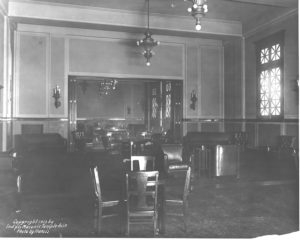
By 2009, both demographics and sentiments had shifted back at the Indianapolis Masonic Temple since the MLMI had formally started there more than twenty years before. As activities in the building slowed down, the resident lodges needed fewer large facilities. That freed up two of the large social rooms that were mostly unused. The Grand Lodge took over one room on the third floor for their expanding records storage. On the fifth floor, Ancient Landmarks Lodge 319 and others had invested heavily in decorating the south lounge, and in 2009 the adjoining north lounge was turned over to the Library and Museum. Additionally, the unused sixth floor candidate preparation rooms were all turned over the to MLMI for their securable archive storage. Everything in Franklin was dismantled, packed up, and trucked back to Indianapolis in hundreds of boxes, but this time the load was much larger.
Grand Master Gregory C. Walbridge named PGM Michael Brumback as the MLMI President in 2011, and after two years of haphazard unpacking of boxes, sorting artifacts on long tables, and throwing books onto shelves at random, serious efforts could begin. In 2011, Brumback began cultivating a working relationship with the Department of Museum Studies at Indiana University-Purdue University Indianapolis. Interns from the department were given a unique opportunity to work in partnership with Masons to create a new and unique museum, virtually from scratch. Building a modern museum from hundreds of boxes of artifacts and archival material was a monumental undertaking requiring not only expertise, but also thousands of hours of labor. For nearly seven years, both the museum and the interns have derived tremendous benefits from this association. In addition to designing a museum with impressive visual presentations, the detailed, photographic cataloging and careful archiving of the vast artifact collection is nearly complete. The Masonic Library and Museum of Indiana of today is a proud achievement for the fraternity. Its contemporary displays are updated and changed regularly, and the archiving and preservation of artifacts continues to be done professionally.
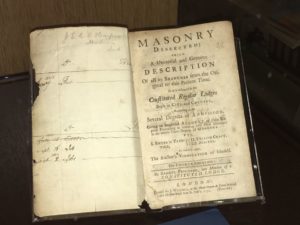 Currently, the Library and Museum’s collections comprise more than 1,500 items. Just a few of its treasures include: a White House foundation stone donated by Harry Truman; a large collection of 19th century Masonic aprons, including that of Kentucky Past Grand Master Joseph Hamilton Daveiss; an extremely rare, early copy of Masonry Dissected, an early 1700s English ritual exposé; unique 18th century Masonic documents; a full set of mid-1800s grand officer’s jewels and their wooden traveling box; countless, scarce officers’ jewels; early lodge decorations and paraphernalia; and other unusual, one of a kind Masonic jewelry. A recent acquisition has been personal Masonic items belonging to Indiana’s Dave Thomas, the late founder of the Wendy’s restaurant empire. Countless other artifacts are displayed on a rotational basis, so the Museum is always changing.
Currently, the Library and Museum’s collections comprise more than 1,500 items. Just a few of its treasures include: a White House foundation stone donated by Harry Truman; a large collection of 19th century Masonic aprons, including that of Kentucky Past Grand Master Joseph Hamilton Daveiss; an extremely rare, early copy of Masonry Dissected, an early 1700s English ritual exposé; unique 18th century Masonic documents; a full set of mid-1800s grand officer’s jewels and their wooden traveling box; countless, scarce officers’ jewels; early lodge decorations and paraphernalia; and other unusual, one of a kind Masonic jewelry. A recent acquisition has been personal Masonic items belonging to Indiana’s Dave Thomas, the late founder of the Wendy’s restaurant empire. Countless other artifacts are displayed on a rotational basis, so the Museum is always changing.
The 2017 installation of a complete security system and other secure precautions has at long last permitted the MLMI to reach out to other institutions and safely borrow important artifacts to bring to Indiana for both the fraternity and the public.
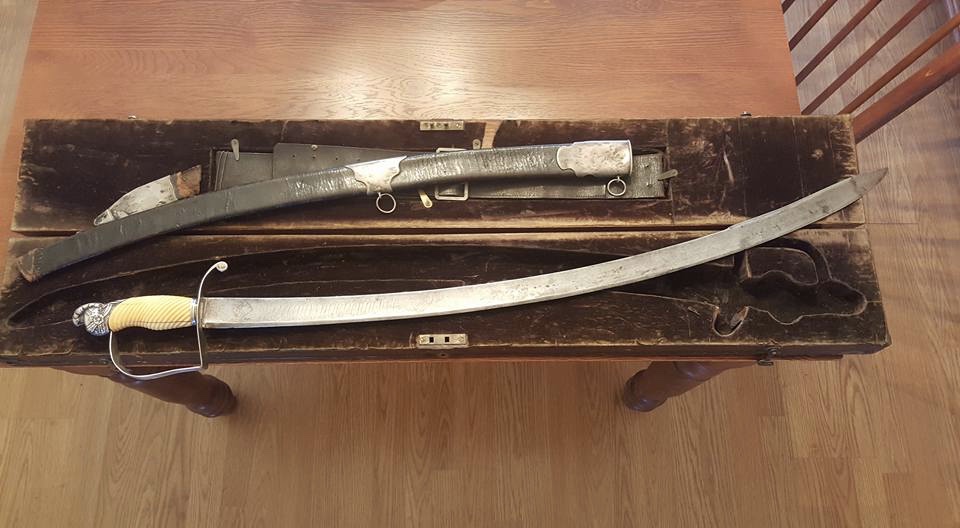 For the Bicentennial year of 2018, the Grand Lodge of Kentucky has graciously loaned the Museum the battle sword of Joseph Daveiss from the Battle of Tippecanoe—an artifact that is swirled in legends all its own.
For the Bicentennial year of 2018, the Grand Lodge of Kentucky has graciously loaned the Museum the battle sword of Joseph Daveiss from the Battle of Tippecanoe—an artifact that is swirled in legends all its own.
 And in January 2018, Virginia’s Fredericksburg Lodge No. 4 permitted the MLMI to display the historic 1668 King James Bible upon which George Washington took his three Masonic obligations between 1752-53.
And in January 2018, Virginia’s Fredericksburg Lodge No. 4 permitted the MLMI to display the historic 1668 King James Bible upon which George Washington took his three Masonic obligations between 1752-53.
The MLMI Board takes great pride not only in the museum, but also in the financial support they have been able to render to its interns. Since 2011, the MLMI has contributed more than $30,000 in college tuition payments and wages to student interns pursuing graduate degrees in Museum Studies at IUPUI. Hiring just one full time museum professional to accomplish this task over the same period of time would likely have multiplied the cost of this endeavor by tenfold. The benefits to the students don’t stop there however. An internship at the MLMI offers them a much more in-depth experience than they can obtain at larger and better funded museums, where they are typically relegated to performing menial tasks. At the MLMI, they become an integral part of nearly every facet of the museum, and they gain valuable experience that prospective employers seldom see on the resumes of new graduates. As a result, MLMI interns have moved on to positions with prestigious institutions like the Getty Museum, the Smithsonian Institution, and the Los Angeles County Museum of Art.
The one great deficiency suffered by the MLMI has admittedly been in the updating of the library. The dedicated labor of Joe Burton was the last serious attempt to catalog the collection, and things were made more chaotic with the move back to Indianapolis. No boxes were marked, and there was no way of knowing what was in any of them once they arrived at the Temple. Many volunteers have worked countless hours just to put the books back into their original systemized organization on the shelves. As a result, there have been few major acquisitions of new study and research material since the early 2000s. The now ancient technology of the card catalog is the sole key to the library’s contents. Brethren with an interest in bringing the library collection into the 21st century are desperately needed to permit this resource to be of serious use to the fraternity and others.
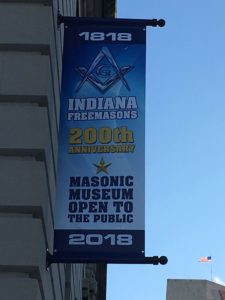 Nevertheless, the Library Museum attracts both Masonic and non-Masonic visitors regularly. Countless people have sought it out to satisfy their curiosity about the fraternity, to rediscover the heritage of their relatives, or to learn more about the role of Freemasonry in the state and their communities. Its location within easy walking distance of the downtown Indianapolis area has brought numerous people just visiting for a convention or event to the doors of the Temple. In addition, the central parts of the city continue to grow with more and more new hotels, apartments, condominiums, and houses each day. As a result, the Temple and the Library Museum continue to be the public face of Indiana Freemasonry for an entire generation of people.
Nevertheless, the Library Museum attracts both Masonic and non-Masonic visitors regularly. Countless people have sought it out to satisfy their curiosity about the fraternity, to rediscover the heritage of their relatives, or to learn more about the role of Freemasonry in the state and their communities. Its location within easy walking distance of the downtown Indianapolis area has brought numerous people just visiting for a convention or event to the doors of the Temple. In addition, the central parts of the city continue to grow with more and more new hotels, apartments, condominiums, and houses each day. As a result, the Temple and the Library Museum continue to be the public face of Indiana Freemasonry for an entire generation of people.
